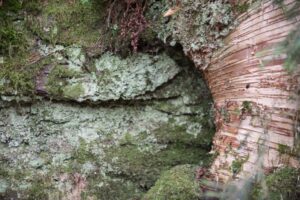
As a program that operates in the lush Green Mountain wilderness of Vermont, True North has valued from its founding the unique and bountiful experience that spending time in nature has to offer, and we are committed to the longevity and preservation of its beauty. For the past few years we have worked closely with the Leave No Trace Center to ensure that the outdoor spaces we visit and inhabit throughout the seasons are adhering to all seven Leave No Trace principles, and that our staff are educated in and practicing the highest level of environmental stewardship, and inherently passing that along to our students.
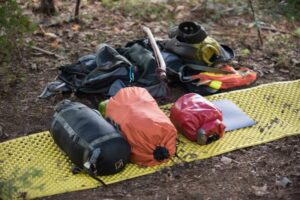
The first principle of Leave No Trace is Plan Ahead and Prepare. True North students connect with the operations department to re-supply the group’s food, as well as other group and individual needs. Each week the group’s guides send out a re-ration list to ensure our students have all that they need for the upcoming week. Pack layouts are performed regularly to ensure the integrity and proper inventory of each student’s gear. Under the guide’s supervision, the students lead the day-to-day orienteering. A guide will check in with the student who is the Hike Lead for that particular week, and develop a plan.
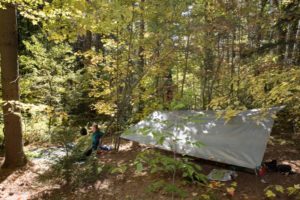 One way that we ensure our impact is minimized is by Traveling / Camping on Durable Surfaces. During the summer program, adolescent groups will typically spend five days of their week bushwhacking through state forest land. Students are spaced apart while hiking so as to not create an unintentional trail. While hiking throughout the week, groups stay at a new backcountry campsite each day. A group is assigned a set of five coordinates at which they are permitted to stay during the week. Coordinates are rotated throughout year to minimize our impact to those particular field areas. After a group has finished their stay at the site, the group area and personal sites are all duffed with leaves and sticks to protect the natural environment but also maintain to the pristine appearance of the backcountry.
One way that we ensure our impact is minimized is by Traveling / Camping on Durable Surfaces. During the summer program, adolescent groups will typically spend five days of their week bushwhacking through state forest land. Students are spaced apart while hiking so as to not create an unintentional trail. While hiking throughout the week, groups stay at a new backcountry campsite each day. A group is assigned a set of five coordinates at which they are permitted to stay during the week. Coordinates are rotated throughout year to minimize our impact to those particular field areas. After a group has finished their stay at the site, the group area and personal sites are all duffed with leaves and sticks to protect the natural environment but also maintain to the pristine appearance of the backcountry.
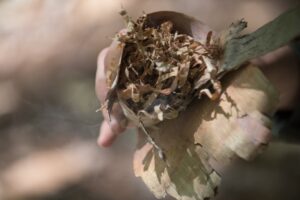 Part of the program curriculum entails harvesting materials from different types of trees. This would normally go against principle three; Leave What You Find. The students are taught by their guides & senior group members how to harvest three materials: paper birch bark to be used for tinder; striped/moose maple used to build small deadfall traps; and small down, dry, dead spruce/pine/balsam fir for constructing a bow drill set. When gathering paper birch we ideally only gather from dead trees, but often we will harvest the strips of bark by pulling down the length the trunk of the tree as opposed to taking from the entire perimeter of the tree, which would leave it stripped bare. This helps to maintain the integrity and health of the tree. When harvesting materials from the field, students and guides are mindful to not strip sites bare, and we only harvest where specimens are abundant.
Part of the program curriculum entails harvesting materials from different types of trees. This would normally go against principle three; Leave What You Find. The students are taught by their guides & senior group members how to harvest three materials: paper birch bark to be used for tinder; striped/moose maple used to build small deadfall traps; and small down, dry, dead spruce/pine/balsam fir for constructing a bow drill set. When gathering paper birch we ideally only gather from dead trees, but often we will harvest the strips of bark by pulling down the length the trunk of the tree as opposed to taking from the entire perimeter of the tree, which would leave it stripped bare. This helps to maintain the integrity and health of the tree. When harvesting materials from the field, students and guides are mindful to not strip sites bare, and we only harvest where specimens are abundant.
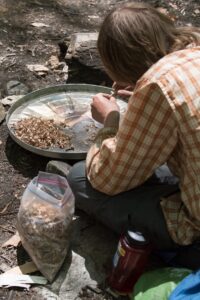 Most fires made at True North take place on top of fire pans or designated fire pits, this way we Minimize Campfire Impact. Steel trash can lids are used on a daily basis as opposed to building fire pits at every campsite, which would not be sustainable. Students collect rocks and place them beneath the fire pan and ground to form a barrier, preventing scorched earth. In addition to the fire pan itself, the area surrounding the fire is cleared of all leaf litter and organic debris to prevent unwanted fire spreading.
Most fires made at True North take place on top of fire pans or designated fire pits, this way we Minimize Campfire Impact. Steel trash can lids are used on a daily basis as opposed to building fire pits at every campsite, which would not be sustainable. Students collect rocks and place them beneath the fire pan and ground to form a barrier, preventing scorched earth. In addition to the fire pan itself, the area surrounding the fire is cleared of all leaf litter and organic debris to prevent unwanted fire spreading.
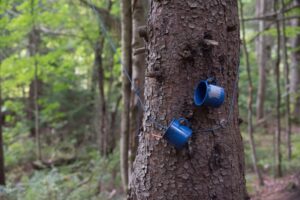
Guides are regularly scanning sites for trash, and making sure that the areas we visit are left looking as untouched as when we arrive (Pack in, Pack out). Before each group departs from a site they will check for micro-trash in all used areas. All bags and containers that are used on the weekly expeditions are kept with the group and then disposed off, when the group is resupplied at the end of the week. The groups, in conjunction with staff, will separate garbage into three categories: recycling, trash, and compost.
True North students are taught to Respect Wildlife from a distance and to respect boundaries. Students will have the opportunity to see squirrels, chipmunks, a plethora of bird species, deer, and maybe even black bear or moose, while traversing the ridges of Vermont’s wilderness. Throughout the student’s stay at True North they will learn to identify the trees native to their surroundings. We are committed to instilling in our students a genuine healthy relationship with their surroundings to maintain the safety of the individual, the group, and our woodland neighbors.
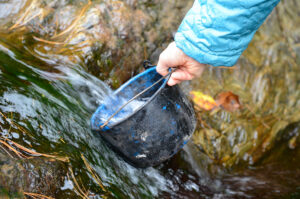
The final principle of Leave No Trace is Be Respectful of Others. For the most part groups tend to stay together 24/7, with the intention of creating a safe, mindful, and distraction free environment. With that being said, groups are kept out of the public eye and secluded to the woods. The field areas that we use are rural and it is uncommon to come in contact with the outside world, however, in situations where fellow outdoor enthusiasts might cross our path, Guides and all other True North employees are trained to intentionally and respectfully navigate any interaction with the public that might arise.

Alex Sears
Blog Author: Alexander Sears. Alex is the Vermont State Advocate for Leave No Trace and we are proud to have him on our Operations Support Team for True North. For Leave No Trace he organizes and teaches trainer courses, awareness workshops, school groups, and works to build social awareness around how to properly recreate in the woods with an emphasis on sustainability.


